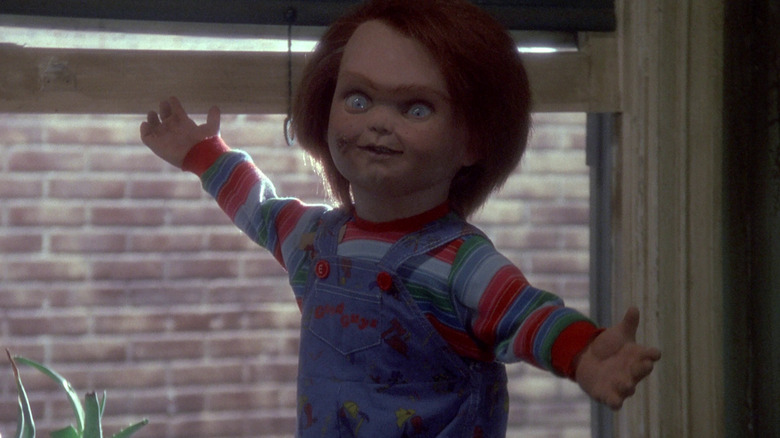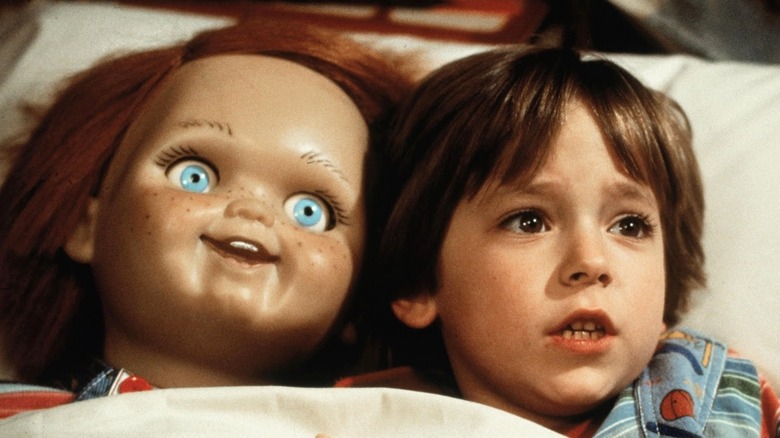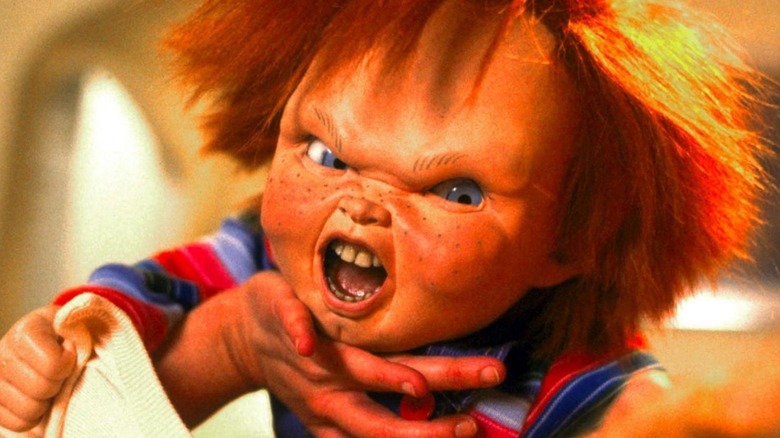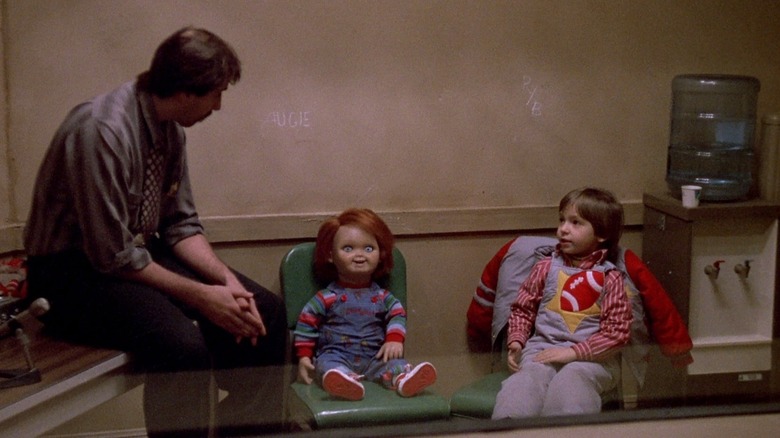1988's Child's Play Ending Explained: Murder Me Elmo
The plot-based mechanics in Tom Holland's 1988 horror film "Child's Play" are pretty straightforward. Vicious serial killer Charles "Chucky" Lee Ray (Brad Dourif), nicknamed the Hillside Strangler, has been idly studying voodoo spells in his spare time. When police detective Mike Norris (Chris Sarandon) gets the drop on Ray in a toy warehouse, fatally shooting him, Ray uses his dying breaths to chant a spell. The magic shunts his soul and all his memories into the body of a two-foot talking plastic doll, called a Good Guy. Chucky will eventually be able to walk around as a doll, speaking in his own voice, and even bleeding. By the rules of "Child's Play" voodoo, if a human soul occupies an inanimate object for too long, said object begins to take on biological components.
Much of "Child's Play" is presented as a mystery, and capably bides its time before Chucky begins attacking people in earnest. A lot of the movie is devoted to the struggles of impoverished mom Karen (Catherine Hicks) as she looks after her young son Andy (Alex Vincent). The Good Guys dolls are a hot new toy product that year, and Karen has to bend over backward to get one for her son's birthday. Naturally, he is gifted the particular doll with a serial killer's soul inside. When Andy begins repeating cuss words Chucky taught him, Karen slowly becomes suspicious, and Mike Norris will be brought in to close the case.
In terms of plot, the end of "Child's Play" is simple. With magic practices at play, it seems that a doll is difficult to kill, and Chucky's soul is slippery. Even when he's set on fire and decapitated, Chucky still lives. Norris puts a bullet in Chucky's heart, and that seems to do the job.
Cabbage Patch Kills
Screenwriter Don Mancini once said that the original title for "Child's Play" was actually "Batteries Not Included," but had to change it when Matthew Robbins was directing a film with the same title. He changed his own screenplay to "Blood Buddy," inspired by the then-popular line of My Buddy dolls. The title was changed yet again after Mancini found that there was already a 1972 Sidney Lumet film called "Blood Buddy." According to an article in Metal Floss, the premise was also changed. In the "Bloody Buddy" version of the script, the killer doll started its life as a toy that had, as a play feature, its own circulatory system, and that would bleed when cut. When the young Andy's blood mixed with the doll's artificial blood, it would come to life and enact Andy's own darkest revenge fantasies.
The premise was eventually changed to a serial killer occupying a doll's body, and they were off to the races.
Hasbro's My Buddy dolls were massively popular, and were riding a wave of "friend/sibling doll" toys that came into vogue after the introduction of Coleco's Cabbage Patch Kids in 1982. One cannot overstate the popularity and ubiquity of Cabbage Patch Kids in the mid-1980s, as the dolls sold by the millions. They featured plastic heads and soft, stuffed bodies, giving them a realistic "you are holding a baby" feeling. Each Kid came pre-named with their own birth certificate, perhaps their most alluring feature for kids. The dolls were so popular, there were literal stampedes to acquire them.
My Bloody
It's notable that the Good Guy dolls in "Child's Play" also came pre-named, and featured cutesy kewpie faces like the Cabbage Patch Kids. Good Guys dressed like My Buddy, and claimed to be their owner's "friend to the end," a promise implied by the "My Buddy" name. Also, they could talk like Teddy Ruxpin, another popular toy that debuted shortly before the release of "Child's Play." Teddy Ruxpin, distributed by Worlds of Wonder in 1985, was a teddy bear equipped with an internal cassette player. The animatronic bear could move its eyes and mouth based on the vocals on the cassette, making it look like it was telling stories.
Chucky, of course, taps into a nightmarish juxtaposition of an innocent childhood object committing acts of violence and murder. Said juxtaposition is the central appeal of the series. A doll is alive and it is killing. This is something that even "The Twilight Zone" understood, and "Child's Play" executes this well-worn premise with flair and chills. But given the film's timing, it's more clearly a satire of the toy-forward consumerist craze of the 1980s. Not only were people trampling each other for plastic-head babies, but much of the decade's kiddie entertainment was more focused on advertising toys than telling stories. See: "Transformers," or "My Little Pony," shows made by Hasbro.
Throughout the 1980s, president Ronald Reagan increasingly deregulated kids' products and, until 1987, it was outright illegal to tie kids' entertainment in with commercials. By 1987, said laws had been overturned, and kids' minds could be legally tainted and branded by marketing.
Ask Gen-X how that turned out for them. Hint: "Transformers" movies are still big business.
Saving Andy's soul
"Child's Play" came out in 1988, right when all the regulations had ended. Chucky wasn't a mere killer doll, but a criticism of the way Ronald Reagan and toy manufacturers were free to sell whatever they wanted — even the souls of murderers — directly to kids.
While the "Child's Play" film series would eventually come to embrace its inherent absurdity — 1998's "Bride of Chucky" is an outright horror comedy — the trends in toy manufacturing never went away. By 1996, Tickle Me Elmo was causing Cabbage Patch-style riots once again. By then, however, consumerist frenzies were the norm, and lampooning them in feature films seemed trite and déclassé. Brian Levant's "Jingle All the Way" tried to mine toy crazes for comedy — a hapless dad attempts to get an ultra-hot Turbo Man for his son on Christmas Eve — but the satire was lacking. Less than a decade after "Child's Play," the world had already come to accept Reagan's reckless deregulation habits from a generation ago. There was no longer any way to fight it.
But for a moment, it seemed possible. At the end of "Child's Play," Chris Sarandon isn't just blasting a hole through a serial killer. He is murdering the very notion of toy consumerism as it pertains to children. He is saving young Andy's soul, not just from being taken over by Charles Lee Ray (Chucky aims to shunt his soul into Andy next), but from the insidious consumption wrought by a Reagan-era marketplace.
In 1988, it seemed the doll was dead; It's telling that Chucky is still alive to wreak havoc today.



